
Fiddle River
Backcountry Planning Guide
Jasper National Park
Backcountry users are the eyes and ears on the trails. Do let us know of issues you may have come upon on your trip by contacting jasperinfo@pc.gc.ca
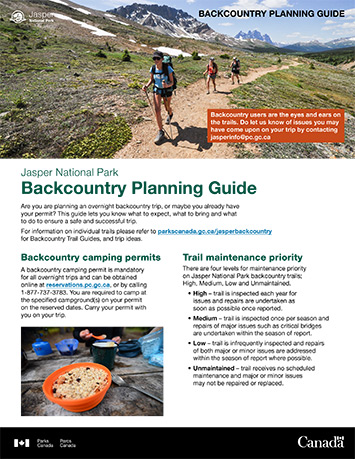 Backcountry Planning Guide (PDF, 756 KB)
Backcountry Planning Guide (PDF, 756 KB)
Backcountry camping permits
A backcountry camping permit is mandatory for all overnight trips and can be obtained online at reservation.pc.gc.ca, or by calling 1-877-737-3783. You are required to camp at the specified campground(s) on your permit on the reserved dates. Carry your permit with you on your trip.
Trail maintenance priority
There are four levels for maintenance priority on Jasper National Park backcountry trails; High, Medium, Low and Unmaintained.- High – trail is inspected each year for issues and repairs are undertaken as soon as possible once reported.
- Medium – trail is inspected once per season and repairs of major issues such as critical bridges are undertaken within the season of report.
- Low – trail is infrequently inspected and repairs of both major or minor issues are addressed within the season of report where possible.
- Unmaintained – trail receives no scheduled maintenance and major or minor issues may not be repaired or replaced.
Campgrounds
Camp only at the campgrounds indicated on your Backcountry Camping Permit and use the numbered tent sites when provided. All backcountry users must have a valid permit for the campground they are using. Stay only at the campground to which your reservation corresponds.
All campground facilities are communal. Please respect other parties by not monopolizing amenities. These common amenities may include tables, fire-pits, docks or shelters.
Food storage
To minimize your campground’s attractiveness to bears and other wildlife, all attractants including food, garbage, toiletries and cooking equipment must be stored securely at all times when not in use. Campgrounds are equipped with food lockers, cable storage, or a pole.
PACK IT IN, PACK IT OUT!
Do not leave anything behind in the campgrounds. Pack out everything you brought, even broken equipment. Park staff DO NOT clean backcountry campgrounds.
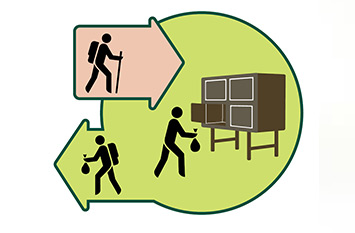
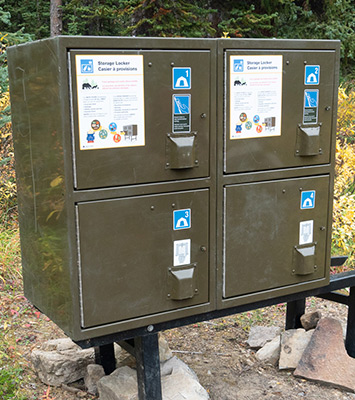
Food lockers
Use any free locker or share a locker if required. Clean your locker and take everything with you when you leave. Park staff do not clean lockers.
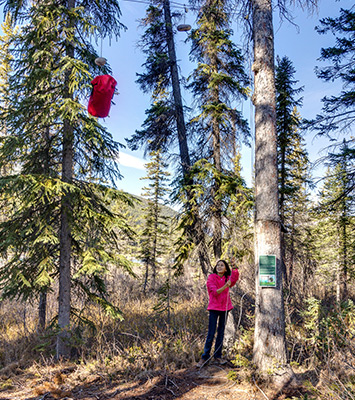
Food storage cables
Bring a carabiner and a sturdy waterproof bag to attach your food to the cables. Do not hang an entire backpack, as the cables are not designed to carry that amount of weight.
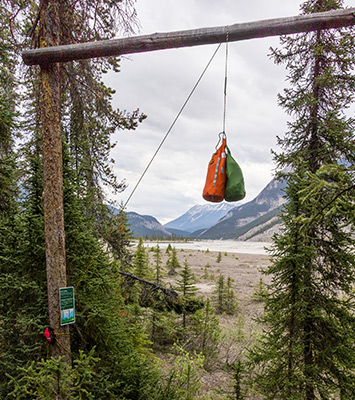
Food storage pole
Bring your own rope (8 – 10 m), a carabiner and a sturdy waterproof bag to hang your food from the horizontal bar. Do not hang an entire backpack, as the horizontal bars are not designed to carry the weight of one or more backpacks.
Tips: Tie a rock to the rope to throw it over the bar. Wrap the rope above the bag with aluminium foil or an aluminium sleeve (a backcountry stove heat shield works well) to prevent rodents from climbing down the rope to your food.
Where no food storage facilities exist
Use a bear-resistant container. Use only containers approved by the Interagency Grizzly Bear Committee.
Store your bear-resistant container at least 30 m downwind from your tent. Choose a spot away from cliffs and water sources.
- The Bare Boxer
Contender Model 101, Champ Model 202
www.bareboxer.com - Craftsman Tech Composites
- Counter Assault
The Bear Keg
www.counterassault.com - Lighter1 Bear Bins – Backpacker Cache
Big Daddy Model (1.03 kg)
Lil’ Sami Model (610 g)
www.lighter1.com - BearVault
www.bearvault.com - Garcia Machine Backpackers’ Cache
Model 812
www.backpackerscache.com - UDAP Industries Inc.
“No Fed Bear” Canister
www.pepperpower.com - Ursack
Food Storage Container
www.ursack.com
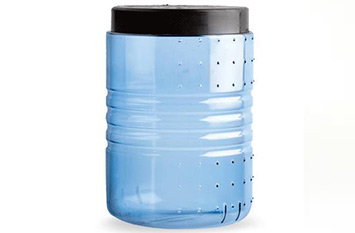
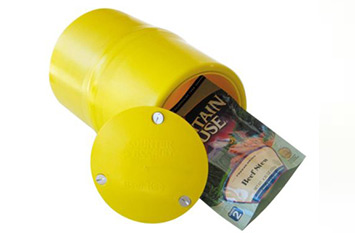
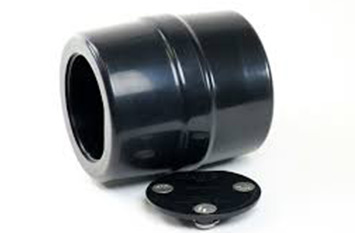
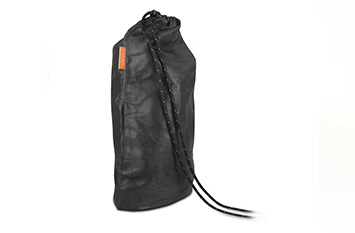
Toilet facilities
Official campgrounds are equipped with barrel toilets, pit toilets (green throne) or bar toilets (remote campgrounds only). You can find this information in the Backcountry Trail Guide specific to your trail. When staying in a campground, always use the provided toilet. When on the trail, use the campground toilets whenever possible. Where there are no facilities nearby, select a spot away from trails, campsites and at least 70 m from water sources. Dig a hole 12 to 16 cm into the dark-coloured, biologically active soil layer. Loosely fill the hole with soil afterward. Use as little toilet paper as possible. Bury the toilet paper completely.
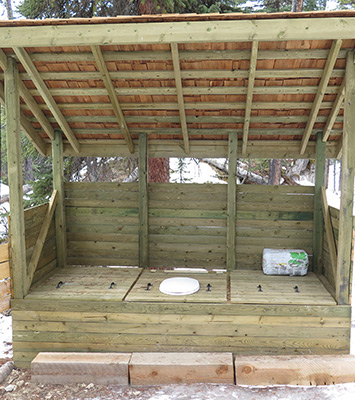
Barrel toilets
These toilets have three seats; a different seat can be used when the barrel below is full. Never put garbage into the barrels; barrels fill faster and it clogs the hoses when they are pumped out. These toilets are used in high elevation trails and other areas where digging pits is not possible. The barrels are flown out by helicopter when full. A barrel is full when the waste is 30 cm (12") from the top.
If all barrels are full, please contact the Information Centre upon completing your trip: 780-852-6176.
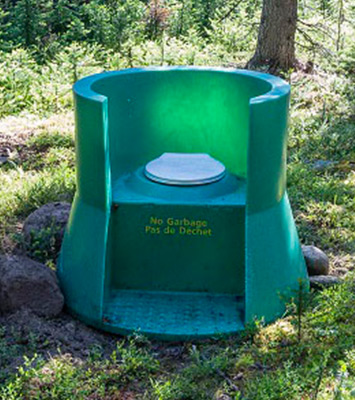
Pit toilets (green throne)
These toilets have a single seat and are often green in colour. These toilets are not located within an enclosure but are situated to provide privacy. These are the most common type of toilet found in backcountry campgrounds.
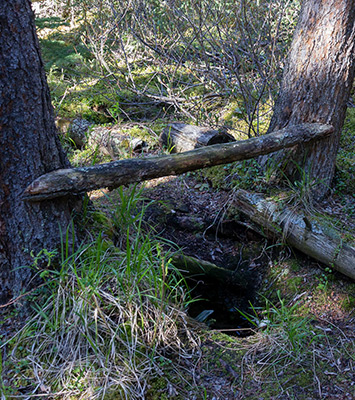
Bar toilets
These toilets are very rustic and are comprised of a bar over a pit toilet area. There is no enclosure or screening to provide privacy. These may be found along low-use and unmaintained trails.
Campfires (where and when permitted)
Fires are only permitted in the provided metal fireboxes.
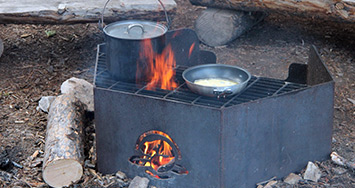
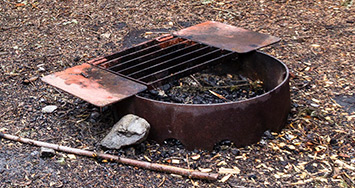
- It is illegal to have a fire outside a firebox
- Keep your fire small and use only provided wood or deadfall. It is illegal to cut trees or branches for fires.
- Tend to your fire at all times and extinguish it completely before you move on.
- Gas stoves are cleaner and more efficient for cooking.
- Check for fire bans on the Jasper National Park trail report before your trip.
- Campfires are NOT allowed in random camping areas. Cooking stoves only; no exceptions.
Water and grey water
Giardia lamblia is a parasite carried by humans and some domestic and wild animals. These parasites can occur in any surface water in the park and may contaminate the water supply. Boil your drinking water or purify it with a water filter or iodine tablets. There is a water source near all campgrounds.
Washing
To wash yourself or your dishes, carry water 70 m away from streams or lakes and use small amounts of biodegradable soap. Strain out those last bits of food waste and pack them out. Disperse strained water on land away from the campground.
Some campgrounds in Jasper have grey water disposal pipes. If these are present strain cleaning water into pipe and pack out any remaining food waste.
Garbage
Pack it in and pack it out! You are responsible for everything you take into the backcountry and this includes garbage. Do not dispose of garbage in toilets—it will attract animals.
Hammocks
Hammocks are permitted at some backcountry campgrounds provided you use webbing straps on the support ropes to protect the trees from which the hammock is hung. Hammocks are not permitted in campgrounds where the trees are not suitable for hammocks. Do NOT hang hammocks from food storage poles. You may damage the poles, or attract wildlife. Choose the trees from which you hang the hammock carefully. An old or rotten tree may fall over when a hammock is hung from it. You are responsible for your own safety.
Hammocks are NOT permitted at:
- Athabasca Island
- All Skyline trail campgrounds
- Jonas Cutoff
- All Fryatt Valley campgrounds
- Second Geraldine Lake
- Tonquin Valley
- Big Bend
Weather
The most predictable thing about mountain weather is its unpredictability. Rain or snow can fall at any time of the year and freezing temperatures are possible even during the summer. The best way to deal with the weather is to prepare for all conditions. Weather forecast
Other things to know
Safety
General
You are responsible for your own safety.
- Tell someone where you’re going and when you plan to return.
- Be aware of wildlife and prepared in the event of an encounter. Carry bear spray and ensure you know how to use it.
- Do your research – know the distances and elevation gain required and any bail-out routes.
- Be prepared for extreme weather and mountainous terrain.
- There is no cell phone coverage in most of Jasper National Park.
Before leaving, check the Jasper National Park trail report for up-to-date trail conditions, fire bans, or warnings/closures.
Wildlife
No matter how tame they may seem, all wildlife is unpredictable and potentially dangerous.
Do not approach or feed ANY wild animal, big or small. Even ground squirrels can bite and they carry some nasty parasites too.
Observe wildlife from a safe distance: at least 30 m (3 bus lengths) for elk and other herbivores and 100 m (10 bus lengths) for bears and other carnivores.
Elk safety
Though they might not appear threatening, elk can be aggressive and attack without warning. In the spring calving season (May – June) female elk aggressively defend their young. During the fall mating season (Aug – Sept), male elk are particularly belligerent. Do not approach elk in any season as they are dangerous.
Ticks and Lyme Disease
Throughout Jasper National Park, from April to November, there is a small chance of being exposed to Lyme disease if bitten by an infected blacklegged (deer) tick. Lyme disease is a serious illness; however, it’s easy to prevent and treat when caught early.
For more information on Lyme disease, blacklegged ticks, and how to protect yourself from tick bites while enjoying the outdoors, please visit the following websites:
Public Health Agency of Canada - Facts about Lyme disease
Alberta Lyme Disease and Tick Surveillance
Etiquette
Do not shortcut trails
Shortcutting off trails damages both the soil and plant life. This not only ruins the look of an area, but makes it susceptible to further damage by erosion.
Do not collect natural or cultural objects
Rocks, fossils, horns, antlers, wildflowers, nests and all other natural or historical objects in a national park are protected by law. Leave them as you found them for others to enjoy.
For more information on low impact travel in the backcountry visit www.leavenotrace.ca
Fishing
A National Park Fishing Permit is required. Provincial fishing permits are not valid in national parks. Permits are sold at park information centres and Jasper retail outlets that sell angling supplies. The Mountain National Parks Fishing Regulations provide information on open seasons, closed waters and limits. All fish waste should be burned hot in the fire rings. This good bear-safe practice will eliminate grease, odours and food attractants. Visit fishing regulations page for more information.
- Date modified :